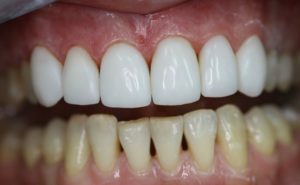 During restoration of teeth it is possible to restore not only their form, but also functions.
During restoration of teeth it is possible to restore not only their form, but also functions.
Correctly matched material allows to form a structure almost similar in strength and appearance with permanent teeth, improving aesthetics and normalizing the physiological state.
Contents of
- What is meant by tooth restoration
- Indications and correctable defects
- Possible limitations and contraindications
- Direct expansion method: pros and cons
- Features of using
- tabs Indirect method
- Using photopolymers
- opinion
questions What is meant by tooth restoration
Usually, speaking of the restoration of the tooth, imply not only the restoration of the tooth build-up, but also bringing it into a proper appearance in accordancewith the rest of the teeth. Therefore, restoration is called cosmetic, artistic or aesthetic.
Indications and correctable defects
Restoration of teeth is recommended in the case of:
-

Photo before and after the
tooth extension of the need for tooth color correction, its shape and size;
- of the wrong tooth position in the row;
- presence of curved teeth;
- treatment of deep caries, which caused severe tooth decay;
- discoloration of the enamel in the form of pigmentation or its darkening.

Using various methods of restoration, it is possible to eliminate the following defects:
- wrong tooth shape;
- chips and irregularities;
- the target between the teeth.
Possible limitations and contraindications
Approaching the decision to restore teeth with caution follows in such situations:
- development of an allergic reaction to the composite or adhesives used during the procedure;
-
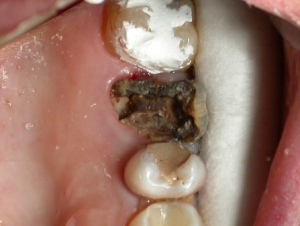
Extensive caries and gangrenous pulpitis
inability to provide tooth insulation against moisture ingress;
- presence of direct bite and abnormal abrasion of the teeth;
- pathological gnashing of teeth;
- insufficient oral hygiene;
- presence of deep incisal overlap;
- inflammation in the gums or extensive caries;
- setting the patient to a heart rate stimulant;
- destruction of dental tissues by more than a third;
- destruction of the subgingival part of the tooth;
- installation on teeth-antagonists of crowns made of metal or cermets;
- lack of teeth of the chewing group, which provokes an incorrect distribution of the masticatory load.
Based on the state of the teeth of a particular patient, the dentist can offer a direct( all manipulations are carried out in the mouth and terminate during one visit) or indirect recovery( most of the work is done without patient involvement).
Direct expansion method: pros and cons
This method is characterized by restoration of the crown part of the tooth using the following materials:
-
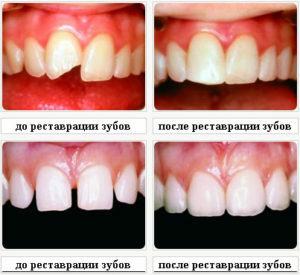
Photo before and after artistic restoration with composite materials
light-curing composite materials or photopolymers .It can be compomers, composites, helio- or nanocomposites;
- special tabs , forming the cavity of the tooth;
- pins made of titanium, fiberglass, silver( the pin is first fixed in the root canal, after which the tooth is extruded).
The last method is shown with a strong fracture of the crown part.
Features of the application of the
tabs When choosing this method, restorations speak of a microstretch. The tabs look like artificial seals made for a specific patient. The dimensions of the tab are determined by the dentist who transmits the data to the prosthetist.
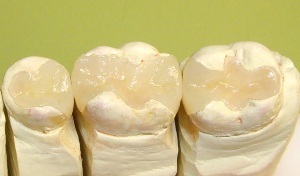
Ceramic inserts
This technique is effective in the presence of deep cavities after treatment of carious processes.
To fill an empty cavity, the tab is the best option, since it fills all the free space and completely repeats the shape of the fissures of the tooth, unlike the usual seal.
Thus, it is possible not only to restore the tooth, but also to prevent the change in occlusion. Also, indications for the use of tabs are injuries, which caused tooth decay due to the breaking off of a large part of the crown.
Restored straight teeth do not create discomfort in the oral cavity due to the joint of the filling and the tooth into a single whole. This feature of the restoration allows us to guarantee the correct functioning of the temporomandibular joint, while preserving the health of the whole organism.
Direct composite front cutter restoration:
Indirect method
It is carried out by installing veneers, crowns or bridges. The greatest aesthetics are provided by veneers, externally having the appearance of covering the anterior surface of the teeth of microprostheses.

Photo before and after aesthetic restoration of teeth with metal-ceramic crowns
Crowns and bridges are effective when there is a need to replace missing teeth, especially if they are teeth of the chewing group, which during the meal have the main load.
The use of photopolymers
The appearance and properties of photopolymers depend on their type:
-
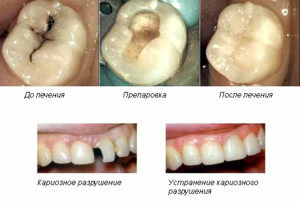
Teeth restoration by the photopolymer
, the compomers are able to release fluoride that strengthens the enamel of the coated tooth;
- heliocomposites are indispensable when you need to recreate the natural light transmission and the selection of the desired color;
- nanocomposites best imitate the optical properties of dental tissues.
Creation of chemical bonds of a composite and enamel of a tooth is reached due to use of a special glue or an adhesive.
The following procedures are performed during the restoration:
-
 Preparation of the underlying tooth correction .It consists of hygienic cleaning of teeth with removal of plaque and calculus, determination of the color of the material on a special scale and the administration of an anesthetic drug( if a "living" tooth with an unrepaired pulp is restored).
Preparation of the underlying tooth correction .It consists of hygienic cleaning of teeth with removal of plaque and calculus, determination of the color of the material on a special scale and the administration of an anesthetic drug( if a "living" tooth with an unrepaired pulp is restored).
In the presence of tooth decay or an old seal, the affected tissue is drilled. - Installation of photopolymer .Before installing the seal, the cavity to be treated is isolated from the saliva using a modern cofferdam material, which is a latex shawl with holes for the teeth. As a result, a tight contact of the filling light-curing material with the tooth tissues is provided.
The photopolymer is applied layer by layer, varying the different shades of the seal and its transparency to achieve the most natural appearance. When the tooth is fully formed, proceed to finish processing, modeling the shape by means of grinding burs. The final stage is polishing the photopolymer seal.
There is an opinion of
The network has numerous reviews of patients who have been made restoration of teeth of this or that complexity.
I always tried to make my teeth white, but even after professional bleaching, after a while the teeth again acquired a yellow tinge.
As a result, I decided to install veneers on the front teeth. For a year now my teeth look absolutely white, however, I have to limit myself in nutrition, refusing solid hard food, which can cause damage to veneers. So along with the positive moment there is also a negative one.
Katerina
Injury turned into a violation of the shape of the tooth. A significant aesthetic defect made us think about restoration. The doctors recommended a crown, but I stopped on the photopolymer. The result fully met expectations, and the restored tooth became indistinguishable from permanent ones.
Tatiana
The appearance of permanent teeth was a real disappointment due to their fineness and curvature, the presence of large interdental spaces. After growing up, I went to a consultation with the orthodontist, intending to install braces, but he replied that I was showing restoration at a dentist-therapist.
As a result, a method of sealing using light-curing material was chosen. I did not even expect such an amazing result. At first, I felt a slight discomfort due to the changed diction, but quickly adapted and completely got used to the new teeth.
Irina
Opening the bottle with teeth led to the cleavage of a piece of the front tooth. Twice in a row they made a filling, but after a while it fell away.
As a result, the tab was made and the pin was installed, after which the tooth was grown to the required length. Now it looks and functions the same as before.
Sergey
Questions to the dentist
What most often interests patients in connection with this issue.
What to choose for augmentation of the front teeth?
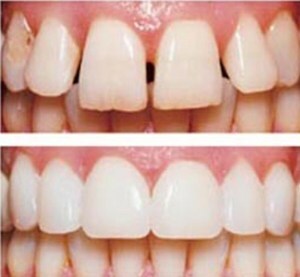
Use of ceramic veneers
Two most frequently used options for the restoration of the front teeth can be distinguished:
- Ceramic veneer - allows to restore the tooth after its damage by more than a third, eliminate the defect in the form of cutting edges of the teeth of the front group, provides a high aesthetics and serves more than 5 years, preserving the external appeal.
- The photopolymer seal is the optimal choice for the restoration of slightly damaged teeth with minimal costs, provided that proper hygiene is provided, the seal is regularly polished( every 6-12 months), and replaced after 5 years.
Is it painful to grow a tooth?
Restoration of teeth is no more painful than their treatment. Discomfort can occur when turning the enamel or during the fixation of the veneer or pin.
If necessary, the dentist makes a decision about anesthesia, reducing negative feelings of the patient to a minimum.
How can I grow fangs and is it possible to do it at home?
Canines can be grown in the following ways:
-
 using a light-curing seal;
using a light-curing seal; - installing the crown of the desired shape.
In both cases, the old form of teeth can not be restored because of the need for obligatory turning, which breaks the integrity of the enamel.
Also, it should be noted that the presence of dilated canines implies more thorough hygienic procedures and food restrictions( when choosing veneers).
Such teeth become simply a decorative element, losing its physiological purpose in the form of providing a quality chewing food.
In addition, the value of canines greater than 4 mm can lead to trauma to the oral mucosa, gums and lips with the development of the inflammatory process.
How is tooth restoration with one wall carried out?
If the root of this tooth is healthy and stays in normal condition, cosmetic restoration is performed by using a pin with subsequent build-up or by fixing the crown after insertion into the root of the stump tab.
According to dentists, the second method is more preferable, as it provides high reliability and aesthetics( when choosing ceramics).
